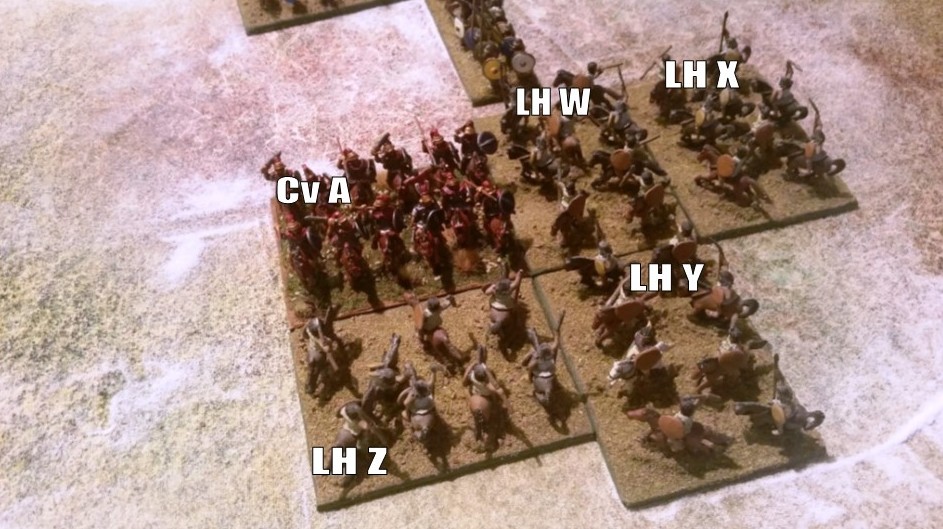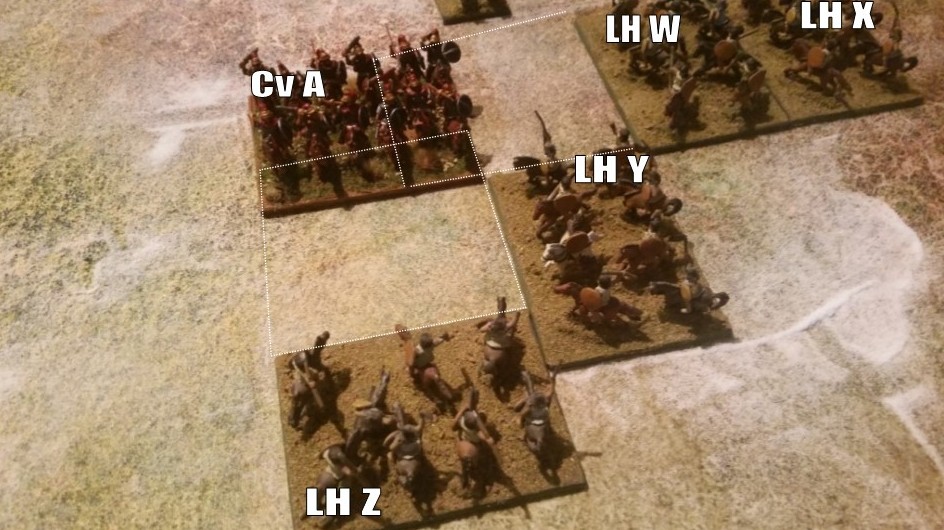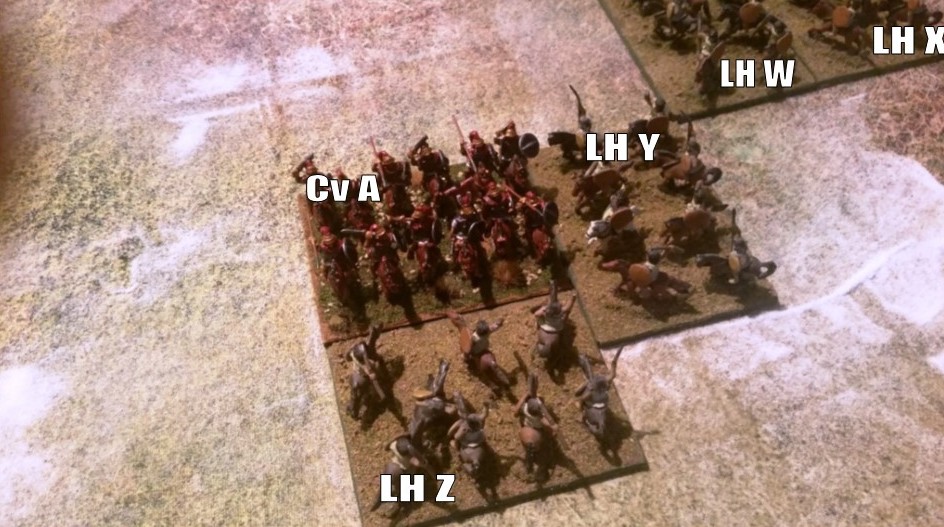|
|
Post by stevie on Jan 22, 2017 10:36:53 GMT
No threat Zone can be ignored in that the moving player can respond to any enemy element whose zone it is in at any point Of its move. The element doesn't "remember "whose zones it started in, it only "knows" which zones it is in. But isn’t that exactly what you are doing if you allow an element that is already in a Threat Zone but which enters a new Threat Zone to do?
If an element that is already committed to a course of action can enter a new Threat Zone and change its target, then it is ignoring the first Threat Zone. And if during the same move it enters yet a third Threat Zone, it could choose any of the three enemy elements to advance against, ignoring the other two.
It’s now hardly being restricted at all!
Entering Threat Zones should be a disadvantage, not an advantage.
By limiting an element in a Threat Zone to line-up or advance against one such enemy that bound (or as Thomas puts it: “you determine which Threat Zone controls movement - either by selecting it if you start in two Threat Zones, or by entering a Threat Zone and starting to move in response”), then you ARE restricting their actions.
After all, I thought that the purpose of Threat Zones was to restrict and limit an element’s movement choices and options... ...not give them more.
|
|
|
|
Post by Dangun on Jan 22, 2017 15:36:28 GMT
My original confusion was thinking that an element in a TZ cannot move into A TZ it was not in originally. But now I think if it does so move, it is able to respond to the new TZ. Either way Bob, your understanding is different to Joe's. Joe's initial reaction, as stated, was that an element in a TZ CAN move into a TZ it was not in originally, but that it was NOT able to respond to the new TZ, it can only respond to the original TZ. May one of the powers-that-be channel Barker and give a ruling? |
|
|
|
Post by primuspilus on Jan 22, 2017 16:34:31 GMT
So now I am thinking about the shenanigans involved when a group in line abreast approaches an enemy group in line abreast, but at on offset angle... In order to still have a playable game, this makes for interesting interpretations of what it means to "move toward" an enemy element. Clearly it does not require lining up parallel with that enemy, or groups would be heavily restricted in their ability to advance to battle. Once can therefore use this example to extrapolate out to what does and does not make sense in moving in TZs.
Elements in the advancing group could easily begin their move in one TZ, and while remaining in the TZ, enter a second one...
|
|
|
|
Post by paulisper on Jan 22, 2017 17:10:00 GMT
That way, madness lies.... Simple, you can respond to any TZ you start in, but forget anything that happens after the moment you begin moving.
P.
|
|
|
|
Post by stevie on Jan 22, 2017 17:36:56 GMT
So now I am thinking about the shenanigans involved when a group in line abreast approaches an enemy group in line abreast, but at on offset angle... In order to still have a playable game, this makes for interesting interpretations of what it means to "move toward" an enemy element. Clearly it does not require lining up parallel with that enemy, or groups would be heavily restricted in their ability to advance to battle. Once can therefore use this example to extrapolate out to what does and does not make sense in moving in TZs. Elements in the advancing group could easily begin their move in one TZ, and while remaining in the TZ, enter a second one... The situation would in fact be much worse than people think. If an element already in a Threat Zone could not enter a NEW Threat Zone, then how could you make contact with a column? You’d enter the column’s first element’s Threat Zone, but then would not be able to advance further into the Threat Zone generated by the rear element of the column. Columns would be immune to attack from the front! Although to be fair, the discussion has moved on from entering Threat Zones to being about whether a element should be able to change targets when it enters a NEW Threat Zone. |
|
|
|
Post by bob on Jan 22, 2017 19:48:30 GMT
Note that the threat zone rule does not allow for any precedents among the three conditions that can exist.
1. An element or group which is at least partly within or
2. whose front edge enters an enemy TZ or
3. touches its far edge can move only:
The rule nowhere indicates that the element only response to the TZ that it started in. The rule says that it applies to an element that starts in OR enters OR touches a TZ. Once an element enters a TZ it can respond to the enemy whose TZ it entered, or the one that it started in.
(a) to line up its front edge with one such enemy generating the TZ or (b) to advance into or towards contact with such an enemy or (c) if a single element, to move straight back to its own rear for the entire move.
The original question neglected to mention the situation of the Roman cavalry moving into the TZ of the lower left facing light course. But that issue was there, so the topic has not changed, just expanded as is often the case in this forum.
|
|
IanC
Munifex

Posts: 16 
|
Post by IanC on Jan 22, 2017 22:08:33 GMT
I did not expect the post to gather this much attention, and a couple of responders mentioned labels - so I have added them. Here is my current interpretation of the responses.  Cv was locked in combat with LH Z from last turn. This turn Group LH W,X,Y (Carthaginians) advanced into contact with (Roman) Cv A  Roman Cv A prevailed pushing back those in contact. In it's turn, Roman Cv A finds itself in the TZ if LH W and LH Z. It follows the requirements of page 9 Threat Zones.... THREAT ZONE
The area 1 BW deep in front any edge of a War Wagon or the front edge of any other type of element or the area within 1 BW of any point of a camp, city or garrisoned fort is its Threat Zone (TZ). An element or group which is at least partly within or whose front edge enters an enemy TZ or touches its far edge can move only:
(a) to line up its front edge with 1 such enemy generating the TZ, or
(b) to advance into or towards contact with such an enemy. or
(c ) if a single element, move straight back to its own rear for the entire move
TZs do not affect outcome moves
It could have single element moved into LH W, or into LH Z, as it was withing the TZ of both. It in fact chose to advance towards LH Z As it did so, it entered the TZ of LH Y, and could have then advanced into it by single element move, forcing it to conform. However, it chose to contact LH Z  Cv A fights LH Z. LH Y is not an overlap as it is not in front corner to corner contact. However, if LH Z wins by any score, Cv A is destroyed as it has enemy in front contact with it flank. Do I have this correct? |
|
IanC
Munifex

Posts: 16 
|
Post by IanC on Jan 22, 2017 22:21:04 GMT
Note that the threat zone rule does not allow for any precedents among the three conditions that can exist. 1. An element or group which is at least partly within or 2. whose front edge enters an enemy TZ or 3. touches its far edge can move only: The rule nowhere indicates that the element only response to the TZ that it started in. The rule says that it applies to an element that starts in OR enters OR touches a TZ. Once an element enters a TZ it can respond to the enemy whose TZ it entered, or the one that it started in. (a) to line up its front edge with one such enemy generating the TZ or (b) to advance into or towards contact with such an enemy or (c) if a single element, to move straight back to its own rear for the entire move. The original question neglected to mention the situation of the Roman cavalry moving into the TZ of the lower left facing light course. But that issue was there, so the topic has not changed, just expanded as is often the case in this forum. My copy of he rules say "touches its far edge". That appears to be important in this example, as at the start of the move, Cv A touches the edge of the TZ of LH Y. It does not however, touch its "far edge". So at the point it begins to move, Cv A enters the TZ of LH Y and is then in the TZ of all three unobstructed LH. It then can chose to advance to advance by single element move, any of LH W, Y or Z provided it has the movement, because, as you say there is no hierarchy as to which condition should be followed first. Is that correct? |
|
|
|
Post by lkmjbc on Jan 23, 2017 2:58:44 GMT
The problems with cascading Threat Zones should be quite obvious. First, such a ruling would directly contradict diagram 7b. Second, the allowance of such would allow elements to possibly move right through multiple threat zones. As each new threat zone is entered... an element may pick a new target. This isn't what was meant for the threat zone rule.
Now, I won't be dramatic and say that it would break the game. Proper alignment of elements will keep this from happening... but still it is silly.
Consider a Blade with a friendly Psiloi behind it. The Ps only has a small sliver directly behind the blade.
An opposing Knight starting in the threat zone of the Blade could move forward to almost contact the Blade... then... being in the Psiloi's threat zone... it could bypass the blade entirely and contact the Ps... Worse... if another element were casting its threat zone near the Ps... the knight could possible further bypass the Psiloi to hit the third element.
We don't want this.
Joe Collins
|
|
|
|
Post by Dangun on Jan 23, 2017 3:28:14 GMT
You are correct. I don't want to be confused. And yet here we are, I am still confused. I can't infer the intent of the rule, nor translate the text of the rule. So can we have a ruling please? |
|
|
|
Post by righteousaussiegamer on Jan 23, 2017 4:31:58 GMT
Consider a Blade with a friendly Psiloi behind it. The Ps only has a small sliver directly behind the blade. An opposing Knight starting in the threat zone of the Blade could move forward to almost contact the Blade... then... being in the Psiloi's threat zone... it could bypass the blade entirely and contact the Ps... Worse... if another element were casting its threat zone near the Ps... the knight could possible further bypass the Psiloi to hit the third element. We don't want this. Joe Collins So good I'll happily say it twice... "We don't want this." below I'm only using caps for clarity. Using only the 'initially in' TZ('s) or (IF NOT, XOR, aka Exclusive Or) then the 'first entered' TZ('s) seems very sensible, very easy, and quite intuitive. I doubt any other rule could be as clear.  Alex. |
|
IanC
Munifex

Posts: 16 
|
Post by IanC on Jan 23, 2017 6:14:13 GMT
So, we want the rule to read.... ?
THREAT ZONE
The area 1 BW deep in front any edge of a War Wagon or the front edge of any other type of element or the area within 1 BW of any point of a camp, city or garrisoned fort is its Threat Zone (TZ). An element or group which is either
(I) at least partly within or if not,
(II) whose front edge enters an enemy TZ or if not
(III) touches its far edge
can move only:
(a) to line up its front edge with 1 such enemy generating the TZ, or
(b) to advance into or towards contact with such an enemy. or
(c ) if a single element, move straight back to its own rear for the entire move
TZs do not affect outcome moves
|
|
|
|
Post by stevie on Jan 23, 2017 7:42:52 GMT
So, we want the rule to read.... ? THREAT ZONE The area 1 BW deep in front any edge of a War Wagon or the front edge of any other type of element or the area within 1 BW of any point of a camp, city or garrisoned fort is its Threat Zone (TZ). An element or group which is either (I) at least partly within or if not, (II) whose front edge enters an enemy TZ or if not (III) touches its far edge can move only: (a) to line up its front edge with 1 such enemy generating the TZ, or (b) to advance into or towards contact with such an enemy. or (c ) if a single element, move straight back to its own rear for the entire move TZs do not affect outcome moves I think it can be made even simpler than that Ian.
The Threat Zone rules are as they are written...we can’t change their wording.
But how do we interpret what is written.
Here is one possible interpretation:-
“...can move only:
(a) to line up its front edge with one such enemy generating the TZ, or
(b) to advance into or towards contact with such an enemy (i.e. one such enemy), or
(c ) if a single element, move straight back to its own rear for the entire move.”
One such enemy...not two, not three, but ONE.
In the entire bound...one such enemy.
So you can’t change targets just because you enter a new threat zone, as that would be targeting MORE than one enemy in a single bound.
In effect it would be as Alex and Joe suggest: the FIRST threat zone matters. It is this that limits and restricts movement.
And if the element begins the bound in more than one threat zone, it chooses which one will affect it for the entire bound, as Thomas suggested.
|
|
|
|
Post by Dangun on Jan 23, 2017 9:46:32 GMT
(a) to line up its front edge with one such enemy generating the TZ, or
This does not work. Even if (and its a big if) you believe that excluding TZs moved into during the turn is desirable, or that excluding TZs moved into during the turn is the intention of the author, this wording does not make it clear. |
|
|
|
Post by stevie on Jan 23, 2017 20:09:35 GMT
(a) to line up its front edge with one such enemy generating the TZ, or
This does not work. Even if (and its a big if) you believe that excluding TZs moved into during the turn is desirable, or that excluding TZs moved into during the turn is the intention of the author, this wording does not make it clear. Of course this wording does not make it clear...that’s why we are having this discussion!
If the Threat Zone wording were clear, then there would be nothing to debate.
As I said in my previous post:-
“The Threat Zone rules are as they are written...we can’t change their wording.
But how do we interpret what is written.
Here is one possible interpretation...”
The truth is, there appears to be a ‘hole’ in the rules, this time about changing targets when entering new threat zones. The rules don’t say you CAN’T, but they don’t say you CAN either.
I was merely offering a suggestion, a possible interpretation:-
• One that fits with diagram 7b.
• One that stops entering new threat zones becoming an advantage instead of a disadvantage.
• One that stops Joe’s example of Kn's bypassing a Bd’s threat zone to get at the Ps behind them.
• One that stops elements bouncing around in multiple threat zones like a ball in a pinball machine.
• One that does not change what is written in the threat zone rules, but gives an alternative way those very same words could be interpreted differently.
But what we really need is arbitration.
We need the FAQ Team to tell us how to interpret the words written on page 9 paragraph 8.
P.S. If you want to make it clear, then change the phrase "one such enemy generating the TZ" to "the first such enemy generating a TZ". That'll do it.
|
|